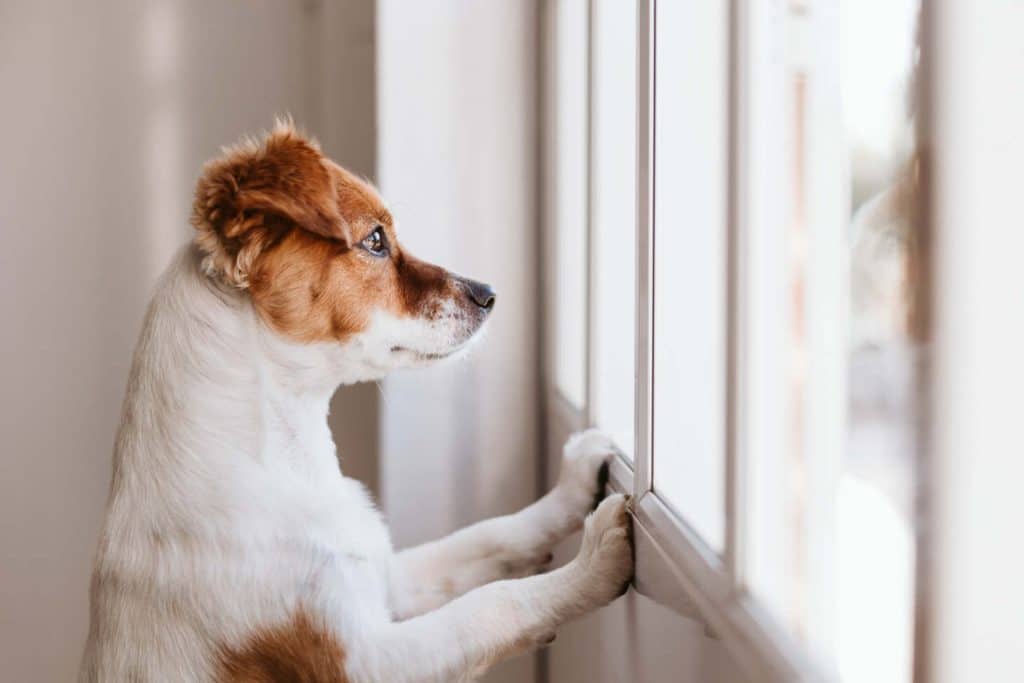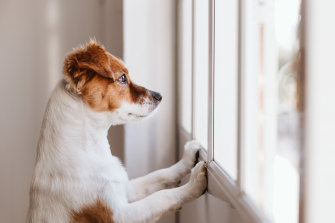
Reproduced from the Sydney Morning Herald,
By Louise Glazebrook
If you’ve ever wondered what your pet gets up to when you leave the house, then you aren’t alone. In recent years, the market for pet technology, such as smart cameras, has rapidly expanded, allowing pet owners to observe their pets’ antics from anywhere, at the click of a button. According to a report by Global Market Insights, the market valuation for pet tech will cross £15 billion (AU$27.8 billion) by 2027.
Scottish scientists at the University of Glasgow have developed DogPhone, a device which allows lonely pets to video call their owners during the day while they’re at work. The phone works by hiding an accelerometer in a ball, which brings up the video conferencing software when shaken.

Although these devices are made with good intentions, the answer to tackling the rise in lonely canines is more complicated. Research suggests that eight out of 10 dogs will find it hard to cope when left on their own, although half of these won’t show any obvious signs of distress. Many of these dogs have separation anxiety, which is a deep-rooted issue that takes months – sometimes years – to solve. Usually, it requires owners working with an experienced behaviourist, or a qualified veterinary behaviourist if medication is required, to help the dog be able to calm down. This would never be the first port of call though.
Video-calling your dog from your desk might put your mind at ease, but some dogs could find it distressing to hear their owners’ voices when they aren’t there. With the use of technology around dogs growing, the one thing we need to remember is that dogs are living, breathing, emotional animals. They are not robots. And we need to stop looking for easy solutions and put more time, effort and money into choosing the right dog, seeking professional help and remembering that one size does not fit all.
Separation distress has always been an issue, but the situation has undoubtedly been made worse by the pandemic. Lockdown restrictions meant that new puppies have got used to being around their owners 24/7. Some owners might not have thought about the work and preparation that goes into teaching a puppy to feel safe and secure when they’re left alone.
So what happens to our dogs’ brains when we leave them alone? If you have an independent dog who is accustomed to being alone, they might be quite happy dozing on the sofa until you get back. The maximum time I would recommend leaving a dog who has no issues being alone is four hours. It’s always best to walk them before, and ensure they have had plenty of mental stimulation during the day.
If we take a dog who struggles with separation anxiety, their brain goes into panic mode as soon as you leave the house. This is because the dog has lost a visual of where their owner is; they have no concept of where you’re going, or how long you will be gone. For some dogs, the panic is most intense in the first 10 minutes, but I’ve experienced first-hand the owners who say their dogs have sustained constant panic for up to three hours. Sometimes “cues”, such as putting your shoes on, or standing by the coat rack, are enough to trigger a response before you have even left the house.
Destructive behaviours should never be punished, as they are a way of the dog trying to regulate their own nervous system. In the same way that humans suck their thumbs, or scroll through their phones, dogs bite, or tear things to try and calm themselves down.
Normally, the first sign of panic is the dog vocalising; they either bark, whine or howl, to let you know that they feel insecure. Some dogs may move on to destructive behaviours, such as scratching the floor, or pawing their crate. Often, they start to pant, which is a stress response that indicates the dog feels unsafe. This can escalate into actual crying, heavier panting, drooling, and frantic behaviours, such as digging the floor, pacing and defecating. All of these indicate the dog is in distress.
Destructive behaviours should never be punished, as they are a way of the dog trying to regulate their own nervous system. In the same way that humans suck their thumbs, or scroll through their phones, dogs bite, or tear things to try and calm themselves down. The longer their owner is away, the more their distress builds.
As soon as you leave the house, levels of cortisol, the stress hormone, and adrenaline, increase in dogs with dependency issues. Sometimes, it can take anywhere between 24 and 48 hours for the cortisol and adrenaline to leave the body. The more often we leave an anxious dog, the more this process happens. This can have a knock-on effect on dogs’ immune systems, digestion and microbiome. It can also lead to bad behaviour; dogs who are routinely put in panic situations are not going to feel safe, so it becomes harder to get your dog to perform the behaviours you want.
This can make owners’ lives miserable, too. Although the world is opening up again, an anxious dog can easily put their owner into another lockdown.
Even well-established pets are affected. Older dogs can be habitual, and owners who have been working from home may have inadvertently undone some of their dogs’ early training. In the first lockdown, my children encouraged our dog Pip, a nine-year-old smooth-haired rescue Collie, to follow us around the house. This meant Pip would be waiting for us by the door when we came in, whereas before he wouldn’t even bother looking up from his spot on the sofa. With owners starting to return to offices, it’s no wonder we are seeing a whole range of dependency problems in dogs.
Some dogs are more susceptible to separation anxiety due to their genetics. At the moment, I’m seeing a lot of clients with cavoodles and miniature smooth-haired dachshunds. This isn’t surprising, given that cavoodles are bred from the cavalier King Charles spaniel, a dog that was originally bred as a companion dog. Many miniature dachshunds are used to being picked up and carried around by their owners.
Tackling separation anxieties in puppies starts with teaching them to feel safe when alone; in older dogs, it’s about identifying triggers.
Ultimately, no dog wants to sit by themselves for nine to 10 hours a day. Before you get one, you should think carefully about whether the life you are going to offer is the one a dog would want. And you should not be looking for a ball that calls an owner to remedy this issue. Dogs are not robots.
5 ways to help your dog cope without you
-
- Only give chews and treat-dispensing toys when you are going to be around. You don’t want these items to become triggers that teach your dog you are going to leave them alone.
- Do not believe that simply shutting a door on your dog will teach them to be left alone. It will have the opposite effect.
- Ensure they are well-exercised. Make sure you include heaps of mental stimulation and games to tire their brain out.
- Allow your dog or puppy to have access to rooms that you aren’t in and can’t see them – even if it means there are toilet training accidents. Make sure you aren’t preventing them from seeking their own independence.
- If they are asleep away from you, do not then pick them up and move them closer to you. Let them rest independently if they choose.
Louise Glazebrook is a dog behaviourist and trainer.
The Telegraph, London


